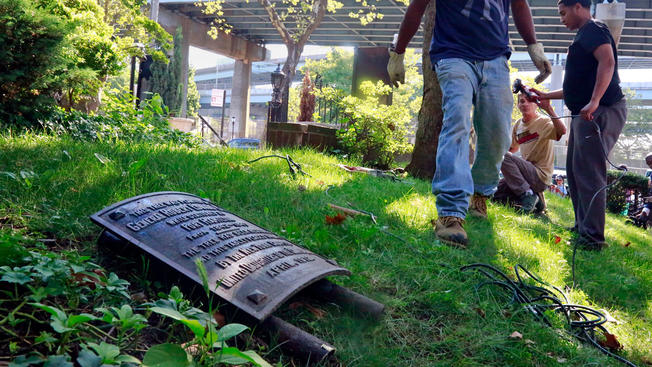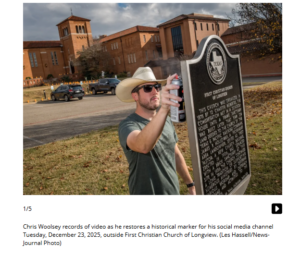VIRGINIA: Episcopalians Struggle With Confederate Past
Recent eruptions of violence over Confederate symbols like the rebel flag have prompted impassioned national debates — and not just in the public arena. Churches, too, are wrestling with the question of what to do with emblems dotting their parishes that memorialize the former slaveholding states and their battle heroes.
It’s in part the continuation of a conversation that was sparked when self-avowed white supremacist Dylann Roof killed nine African-American parishioners during a Bible study at a church in Charleston, South Carolina, in 2015. Roof was seen brandishing a Confederate flag in photographs that surfaced after his arrest. He is currently on federal death row.
The shock and turmoil of the shooting at Emanuel A.M.E., the South’s oldest black church, prompted the removal of a Confederate battle flag from the Statehouse grounds in Columbia. And then came Charlottesville, Virginia. When violence erupted there in August at a rally of white nationalists opposed to the removal of a statue of Gen. Robert E. Lee, calls for taking down Confederate monuments accelerated.
Many churches date back to Civil War times and beyond and found themselves on the side of the pro-slavery South when their sons marched off to war. The war ended, as did slavery — but the racism did not.
“You do have an identifiable connection to the Confederacy,” said Doug Thompson, history professor at Mercer University in Macon, Georgia. He said Episcopal churches prayed for the president of the Confederacy, not the Union, during the war. “Episcopalians have built into their very structure an attachment to this national identity.”
Just steps away from the Statehouse, the Trinity Episcopal Cathedral is wrestling with Confederate ghosts. The South’s Gen. Wade Hampton and its poet laureate, Henry Timrod, are buried on the parish’s grounds. A plaque in its sanctuary honors members who died in the Civil War. However, the church doesn’t allow the display of Confederate flags, and the Very Rev. Dean Timothy Jones said Confederate flags recently placed on soldiers’ graves were removed.
“I care deeply about how historical symbols can create hurt and communicate a message of discrimination,” Jones said. “We believe in redressing the terrible wrongs of slavery and affirming the dignity of every human being.
Several weeks after the church shootings, delegates to the national Episcopal church’s convention passed a resolution calling for the removal of Confederate battle flags from display. The call included not only taking down actual flags but also the removal of the images from iconography, like plaques and stained glass windows. Afterward, Washington National Cathedral, which is Episcopal, announced its plan to remove Confederate battle flags from two windows honoring Confederate generals Lee and Thomas “Stonewall” Jackson, saying later it would remove the windows entirely and store them pending a future decision about their fate.

A plaque, one of two honoring Confederate Gen. Robert E. Lee, lies on the ground after workers removed it from the property of St. John’s Episcopal Church, Aug. 16, 2017, in the Bay Ridge section of Brooklyn, New York. The removal comes in the wake of a deadly white nationalist rally in Charlottesville, Virginia, where white supremacists protested plans to remove a Lee statue from a public park.
St. Paul’s Episcopal Church in Richmond, Virginia, is known as the “Cathedral of the Confederacy” — Lee worshipped there, as did Jefferson Davis, president of the Confederacy, who was a member of the church. In the 1890s, it became popular to memorialize family members with sanctuary wall plaques, and several sprung up in St. Paul’s that honor Confederate soldiers, some decorated with battle flags. The church vestry voted to remove the battle flags in November 2015. The kneelers with the Confederate flag in needlepoint are also gone, and the church retired its coat of arms.
In Cincinnati, leaders of a historic Episcopal church there are considering whether a pair of stained-glass memorials to Lee and Episcopal Bishop Leonidas Polk, who also served as a Confederate general, should be removed.
The Lexington, Virginia, church where Lee worshipped after the war — renamed R. E. Lee Episcopal decades after his death — considered but ultimately voted down a name change in 2015. Another recent vote on the issue showed church leaders remained divided, although the church said it objected “strenuously” to the use of Lee’s name in connection with white supremacists.
Non-Episcopal churches are also grappling with Confederate symbols. The Southern Baptist Convention, for one, has been working to overcome its earlier support for slavery. Last year, the convention adopted a resolution urging “brothers and sisters in Christ discontinue the display of the Confederate battle flag.” In 1995, a resolution was approved asking for forgiveness from African-American Christians.
Trustees of a Unitarian church in Portland, Maine, said last month they were considering removing a plaque honoring Confederacy president Davis, adding they weren’t even sure why it was installed or why Davis — who wasn’t a Unitarian — would have visited the church.
The gestures haven’t gone unnoticed, but some within the black church community have questioned why it took a tragedy like the Charleston murders to spark the conversation about Confederate symbolism.
“Why did it take the murder of nine black people in a Bible study for some people to finally reject the racism associated with the Confederate emblem? Why do people have to literally be killed before we confront racial prejudice?” Jemar Tisby, president of the Reformed African American Network, wrote earlier this year.
–Associated Press

![[NATL] WATCH: Confederate Flag Comes Down](https://media.nbclosangeles.com/images/620*349/NC_flag110710001_1500x845.jpg)

